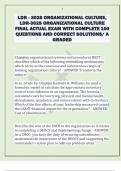1 LDR - 302S ORGANIZATIONAL CULTURE, LDR -302S ORGANIZATIONAL CULTURE FINAL ACTUAL EXAM WITH COMPLETE 100 QUESTIONS AND CORRECT SOLUTIONS/ A GRADED Changing organizational systems and procedures BEST describes which of the following embedding mechanisms, which serve as the conscious and subconscious ways of forming organization culture? - ANSWER Transform the culture In an article by Chaplain Kenneth R. Williams, he used a formulaic model to calculate the approximate monetary costs of toxic behavior in an organization. The formula calculated costs for worrying, physical and mental health, absenteeism, avoidance, and co nversations with co -workers. Which of the five effects of toxic leadership measured caused the LEAST financial impact for the organization? - ANSWER Cost of absenteeism Describe the role of the SNCO in the organization as it relates to completing a DEOCS and implementing change - ANSWER As a SNCO, you have the duty of ensuring subordinates understand the importance of the DEOCS and supporting the commander's action plan t o address problem areas. 2 DOECS Phase 1 - ANSWER -PLANNING STAGE - During the planning stage, clearly define the purpose of the assessment, list all resources required to administer the assessment, identify supporting staff required to execute the organizational assessment, identify the organization(s) being assessed, collect organization demographics and unit composition, and identify the types of assessment methods that will be used during the assessment. - PLAN DEVELOPMENT - The Plan Development stage results in developing a time line to guide and forge coordination and synchronization efforts across the organization(s). Once coordination is complete and the order is approved, the assessment team needs to d evelop an in -brief for the commander/director. - COMMANDER IN -BRIEF - Begin the briefing by introducing the team. Then brief the key points on the plan concept and who will be involved. It should discuss the proposed timeline, expectations for completion, and how and when other assessment methods may be employed. At the end of the brief, ask for additional guidance and plan approval. Once the commander has approved the plan or provided additional guidance and notified the participants, the team is ready to move to Phase 2 "Conduct." - NOTIFICATION - Once the commander/director has approved the plan and order, prepare to release the order in accordance with your organization's protocol. Next, brief key leaders on the plan concept to maximize support and employee participation. Additiona lly, do not forget to reconfirm participants in preparation for Phase 2 3 Describe the seven principles of Mission Command - ANSWER COMPETENCE - Commanders and subordinates achieve the level of competence to perform assigned tasks to standard through training, education, assignment experience, and professional development. Comman ders continually assess the competence of their subordinates and their organizations. This assessment informs the degree of trust commanders have in their subordinates' ability to execute mission orders in a decentralized fashion at acceptable levels of ri sk MUTUAL TRUST - Mutual trust is shared confidence between commanders, subordinates, and partners that they can be relied on and are competent in performing their assigned tasks. Trust is given by leaders and subordinates, and built over time based on common shared experiences. It is the result of upholding the Army values, exercising leadership consistent with Army leadership principles, and most effectively instilled by the leader's personal example. SHARED UNDERSTANDING - Shared understanding of the situation, along with the flow of information to the lowest possible level, forms the basis for unity of effort and subordinates' initiative. Effective decentralized execution is not possible without shared understanding. Shared understanding starts with the Army's doctrine and professional military education that instills a common approach to the conduct of operations, a common professional language, and a common understanding of the principles of mission c ommand. 4 COMMANDERS INTENT - The commander's intent is a clear and concise expression of the purpose of the operation and the desired military end state that supports mission command, provides focus to the staff, and helps subordinate and supporting commanders act t o achieve the commander's desired results without further orders, even when the operation does not unfold as planned MISSION ORDER - An order is a communication —ver Explain how the human and organizational dimensions of trust impact Mission Command - ANSWER It is in the human dimension that leaders establish the climate of respect, honesty, and trust. As research indicates, when subordinates trust their leaders, they are willing to follow and trust in their actions. Intraorganizational trust, which is the trust among the members and entities of a single organization, is closely linked to the human dimension of trust through esprit de corps. Research has shown that orga nizations with high levels of intraorganizational trust not only perform better but also show higher levels of esprit de corps. Describe the three attributes of Mission Command - ANSWER Airmen execute mission command through centralized command, distributed control, and decentralized execution. Centralized command is the organizing standard for the effective and efficient means of employing airpower; it enables the principle of mass while maintaining the principle of economy of force. Because of airpower's potential to directly affect the strategic and operational levels of warfare, it should be commanded by a single




